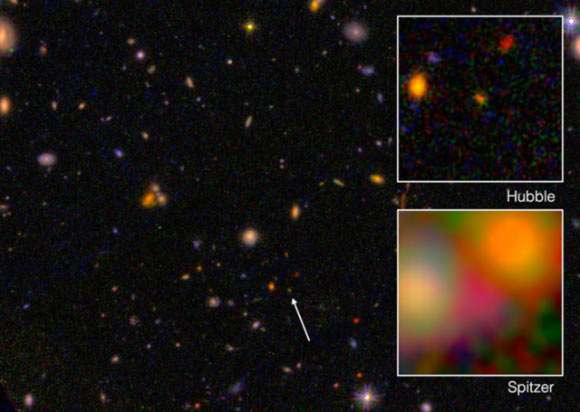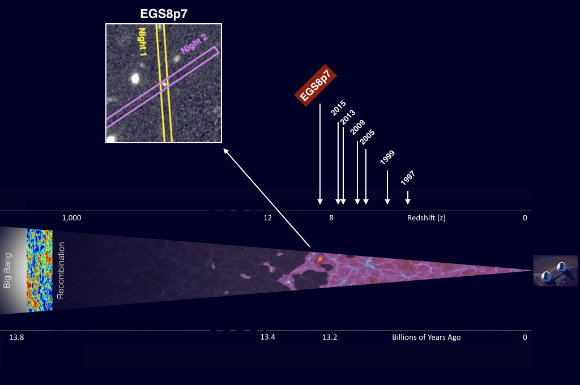Known by its catalog name, EGSY-2008532660 (EGSY8p7 for short), the galaxy is so far away that light from it now reaching ground-based telescopes shows the galaxy as it existed 13.2 billion years ago.

EGSY8p7 is the most distant confirmed galaxy whose spectrum obtained with the W. M. Keck Observatory places it at a redshift of 8.68 at a time when the Universe was less than 600 million years old. Image credit: NASA / ESA / JPL-Caltech / I. Labbe, Leiden University.
“This is a time when we believe the first galaxies were formed and had a considerable effect on the evolution of the Universe,” said Guido Roberts-Borsani from Leiden Observatory in the Netherlands and University College London in UK.
“Finding galaxies at such an early age is rare and provides us with a unique insight into the conditions that allowed these objects to form. We are looking at the very first moments of galaxy formation.”
EGSY8p7 was initially identified by Roberts-Borsani and his colleagues using the Hubble and Spitzer Space Telescopes.
The galaxy’s record-breaking distance was subsequently confirmed by the scientists using the MOSFIRE spectrograph at the W.M. Keck Observatory in Hawaii.
They dated the galaxy by detecting its Lyman-alpha emission line – a signature of hot hydrogen gas heated by strong UV emission from newly born stars.
Although this is a frequently detected signature in galaxies close to Earth, the detection of Lyman-alpha emission at such a great distance is unexpected as it is easily absorbed by the numerous hydrogen atoms thought to pervade the space between galaxies at the dawn of the Universe.
“The surprising aspect about the discovery is that we have detected hydrogen emission in this galaxy at a redshift of 8.68, corresponding to a time when the Universe was just under 600 million years old and should be full of absorbing hydrogen clouds,” said Dr Richard Ellis from the California Institute of Technology, a co-author of a paper accepted for publication in the Astrophysical Journal Letters (arXiv.org preprint).

EGSY8p7 in the epoch of reionization. The illustration shows the remarkable progress made in recent years in probing early cosmic history. Such studies are important in understanding how the Universe evolved from an early dark period to one when galaxies began to shine. Hydrogen emission from EGSY8p7 may indicate it is the first known example of an early generation of young galaxies emitting unusually strong radiation. Image credit: Adi Zitrin / California Institute of Technology.
“Quite apart from breaking the earlier record redshift of 7.73, when the Universe was just under 700 million years old, this detection is telling us something new about how the Universe evolved in its first few hundred million years.”
The result gives new insight into ‘cosmic reionization,’ the process by which dark clouds of hydrogen were split into their constituent protons and electrons by the first generation of galaxies.
“We frequently see the Lyman-alpha emission line of hydrogen in nearby objects as it is one of most reliable tracers of star-formation,” said lead author Dr Adi Zitrin, also from the California Institute of Technology.
“However, as we penetrate deeper into the Universe, and hence back to earlier times, the space between galaxies contains an increasing number of dark clouds of hydrogen which absorb this signal.”
“The period of cosmic reionization is the final missing piece in our overall picture of the evolution of the cosmos. While it’s exciting that we can push back the frontier to a time when Universe was less than 5 percent of its present age, the importance of the present discovery is that detailed studies of exceptional objects like EGSY8p7 can offer new insight into how the first galaxies formed,” Dr Ellis concluded.
_____
Adi Zitrin et al. 2015. Lyman-alpha Emission from a Luminous z=8.68 Galaxy: Implications for Galaxies as Tracers of Cosmic Reionization. ApJL, submitted for publication; arXiv: 1507.02679







